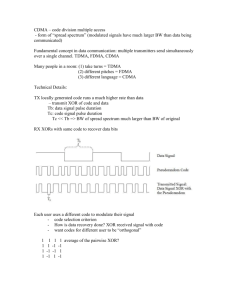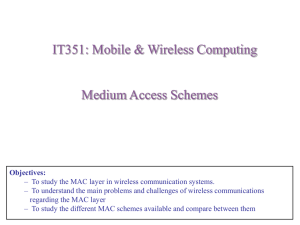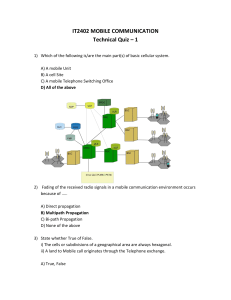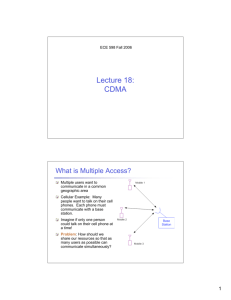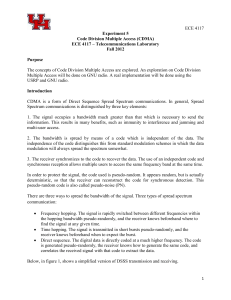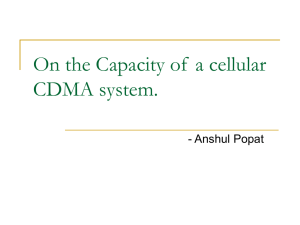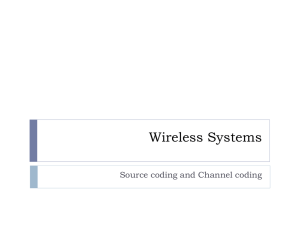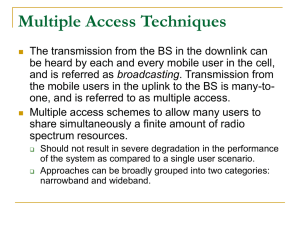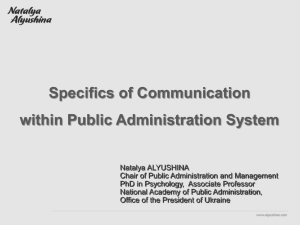EEC289Q Computer Networks
advertisement
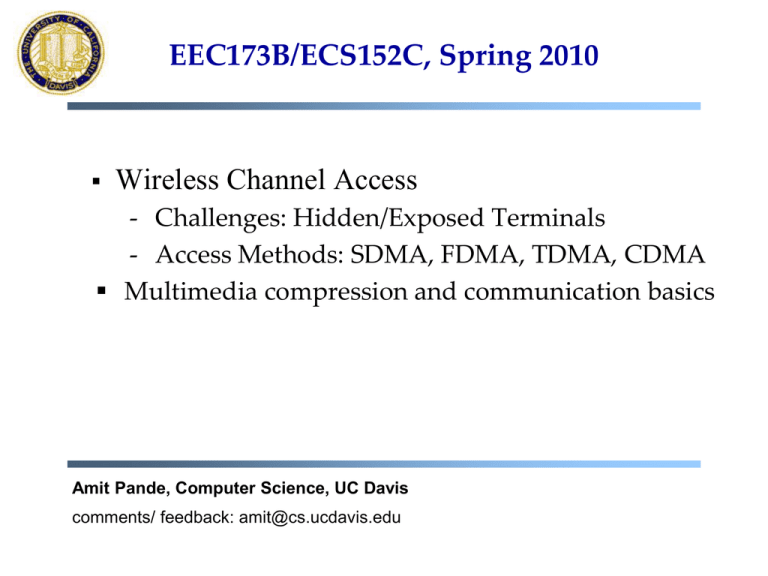
EEC173B/ECS152C, Spring 2010 Wireless Channel Access - Challenges: Hidden/Exposed Terminals - Access Methods: SDMA, FDMA, TDMA, CDMA Multimedia compression and communication basics Amit Pande, Computer Science, UC Davis comments/ feedback: amit@cs.ucdavis.edu Medium Access Sublayer Medium Access Control (MAC) Protocols Network Data Link Physical Medium Access Sublayer --- distributed algorithm that arbitrate access to a common shared channel among a population of users, i.e., determine when a node can transmit 2 Remarks on MAC Sublayer MAC is not important on point-to-point links MAC is only used in broadcast or shared channel networks - Only one can send successfully at a time Two or more simultaneous transmissions => interference How to share a broadcast channel? Communication about “sharing” must use the channel itself! Examples: - Packet-switched Radio Network (Aloha) Ethernet IEEE 802.3 (CSMA/CD) Token Ring IEEE 802.5, FDDI (Token Passing) Cellular, Satellite, Wireless LAN (MACAW) 3 Motivation Can we apply media access methods from fixed networks? Example CSMA/CD - Carrier Sense Multiple Access with Collision Detection - Send as soon as the medium is free, listen into the medium if a collision occurs (original method in IEEE 802.3) 4 Problems in wireless networks Signal strength decreases proportional to the square of the distance The sender would apply CS and CD, but the collisions happen at the receiver It might be the case that a sender cannot “hear” the collision, i.e., CD does not work Furthermore, CS might not work if, e.g., a terminal is “hidden” 5 Hidden Terminals Hidden terminals - A sends to B, C cannot receive A C wants to send to B, C senses a “free” medium (CS fails) Collision at B, A cannot receive the collision (CD fails) A is “hidden” for C A B C 6 Exposed Terminals Exposed terminals - B sends to A, C wants to send to another terminal (not A or B) C has to wait, CS signals a medium in use But A is outside the radio range of C, waiting is not necessary! C is “exposed” to B A B C D 7 Near and Far Terminals Terminals A and B send, C receives - Signal strength decreases proportional to the square of the distance - The signal of terminal B therefore drowns out A’s signal - C cannot receive A A B C If C for example was an arbiter for sending rights, terminal B would drown out terminal A already on the physical layer Also severe problem for CDMA-networks - Precise power control needed! 8 Taxonomy of MAC Protocols 9 Controlled Access methods SDMA (Space Division Multiple Access) - Segment space into sectors, use directed antennas - Cell structure FDMA (Frequency Division Multiple Access) - Assign a certain frequency to a transmission channel between a sender and a receiver - Permanent (e.g., radio broadcast), slow hopping (e.g., GSM), fast hopping (FHSS, Frequency Hopping Spread Spectrum) TDMA (Time Division Multiple Access) - Assign the fixed sending frequency to a transmission channel between a sender and a receiver for a certain amount of time => The multiplexing schemes presented before are now used to control medium access! 10 FDD/FDMA – e.g., GSM f 960 MHz 935.2 MHz 124 200 kHz 1 20 MHz 915 MHz 890.2 MHz 124 1 t 11 TDD/TDMA, e.g., DECT 417 µs 1 2 3 downlink 11 12 1 2 3 uplink 11 12 t 12 CDMA (Code Division Multiple Access) All terminals send on the same frequency probably at the same time and can use the whole bandwidth of the transmission channel - Each sender has a unique random number, the sender XORs the signal with this random number - The receiver can “tune” into this signal if it knows the pseudo random number, tuning is done via a correlation function 13 CDMA – Cont’d Disadvantages: - Higher complexity of a receiver (receiver cannot just listen into the medium and start receiving if there is a signal) - All signals should have the same strength at a receiver Advantages: - All terminals can use the same frequency, no planning needed Huge code space (e.g. 232) compared to frequency space Interferences (e.g. white noise) is not coded Forward error correction and encryption can be easily integrated 14 CDMA: An Example Sender A - Sends Ad = 1, key Ak = 010011 (assign: “0“= -1, „1“= +1) - Sending signal As = Ad * Ak = (-1, +1, -1, -1, +1, +1) Sender B - Sends Bd = 0, key Bk = 110101 (assign: “0“= -1, „1“= +1) - Sending signal Bs = Bd * Bk = (-1, -1, +1, -1, +1, -1) Both signals superimpose in space - Interference neglected (noise etc.) - As + Bs = (-2, 0, 0, -2, +2, 0) Receiver wants to receive signal from sender A - Apply key Ak bitwise (inner product) • Ae = (-2, 0, 0, -2, +2, 0) Ak = 2 + 0 + 0 + 2 + 2 + 0 = 6 • Result greater than 0, therefore, original bit was “1“ - Receiving B • Be = (-2, 0, 0, -2, +2, 0) Bk = -2 + 0 + 0 - 2 - 2 + 0 = -6, i.e. “0“ 15 Another Example: CDMA on signal level (1) data A 1 0 Ad 1 key A key sequence A data key 0 1 0 1 0 0 1 0 0 0 1 0 1 1 0 0 1 1 1 0 1 0 1 1 1 0 0 0 1 0 0 0 1 1 0 0 signal A Ak As Real systems use much longer keys resulting in a larger distance between single code words in code space. • For this example, ‘0’ is high, ‘1’ is low. 16 CDMA on signal level (2) As signal A data B key B key sequence B data key signal B 1 0 Bd 0 0 0 0 1 1 0 1 0 1 0 0 0 0 1 0 1 1 1 1 1 1 0 1 0 1 0 0 0 1 0 1 1 1 0 1 0 Bk Bs As + B s 17 CDMA on signal level (3) data A 1 0 1 1 0 1 Ad As + B s Ak (As + Bs) * Ak integrator output comparator output 18 CDMA on signal level (4) data B 1 0 0 1 0 0 Bd As + B s Bk (As + Bs) * Bk integrator output comparator output 19 CDMA on signal level (5) As + B s wrong key K (As + Bs) *K integrator output comparator output (0) (0) ? 20 Implications for High-Speed Wireless Data Controlled multiple access performs well with continuous stream traffic but inefficient for bursty traffic Complexity: frequency division < time division < code division Multiple data rates - Multiple frequency bands - Multiple time slots - Multiple codes 21 Comparison SDMA/TDMA/FDMA/CDMA Approach Idea SDMA segment space into cells/sectors Terminals only one terminal can be active in one cell/one sector Signal separation cell structure, directed antennas TDMA segment sending time into disjoint time-slots, demand driven or fixed patterns all terminals are active for short periods of time on the same frequency synchronization in the time domain FDMA segment the frequency band into disjoint sub-bands CDMA spread the spectrum using orthogonal codes every terminal has its all terminals can be active own frequency, at the same place at the uninterrupted same moment, uninterrupted filtering in the code plus special frequency domain receivers Advantages very simple, increases established, fully simple, established, robust inflexible, antennas Disadvantages typically fixed inflexible, frequencies are a scarce resource flexible, less frequency planning needed, soft handover complex receivers, needs more complicated power control for senders typically combined with TDMA (frequency hopping patterns) and SDMA (frequency reuse) still faces some problems, higher complexity, lowered expectations; will be integrated with TDMA/FDMA capacity per km² Comment only in combination with TDMA, FDMA or CDMA useful digital, flexible guard space needed (multipath propagation), synchronization difficult standard in fixed networks, together with FDMA/SDMA used in many mobile networks 22 Video coding & communications state-of-the-art 23 Application Scenario 24 Terms Sampling RGB – YUV - Sampling 4:4:4 4:2:2 4:2:0 25 Steps Prediction Model Spatial Model Entropy Coding - Huffman coder - Arithmetic Coder 26 27 Overview of H.264 / AVC Latest Video coding standard Basic design architecture similar to MPEG-x or H.26x Better compression efficiency - Upto 50% bitrate reduction from the preceding video codec standard Subjective quality is better Advanced functional element Wide variety of applications such as video broadcasting, video streaming, video conferencing, D-Cinema, HDTV. Layered structure - consists of two layers: Network Abstraction Layer (NAL) and Video Coding Layer (VCL); supports 4:2:0 chroma sampling picture format including QCIF and CIF formats 28 H.264/AVC Profiles Profiles and Levels for particular applications - Profile : a subset of entire bit stream of syntax, different decoder design based on the Profile • Four profiles : Baseline, Main, Extended and High Profile Baseline Main Applications Video Conferencing Videophone Digital Storage Media Television Broadcasting Extended Streaming Video High Studio editing 29 Specific coding parts for the Profiles 30 H.264 Encoder (contd.) 31 32 33 34 4G Mobile BWA networks Design QoS oriented New techniques aimed to improve the reliability and the efficiency Enable the delivery of mobile videoon-demand services to mobile users 35 New techniques Explicit QoS support Frequency selective scheduling with OFDMA Adaptive Modulation and Coding with new modulations available Enhanced data protection mechanisms (H-ARQ) Multiple Input Multiple Output Relay nodes 36 Open issues Channel variability Bandwidth and resource management: - Call admission control - Scheduling algorithms (QoE oriented) eMBMS (Multimedia Broadcast Multicast Service) vs unicast Multi-layer approach 37 Scalable video coding and wireless Scalable video coding can deal with some of the issue: - Dynamic channel condition - High error channels Others issues: - Heterogeneous clients 38 Thanks Amit Pande Got questions? www.cs.ucdavis.edu/~amit 39
